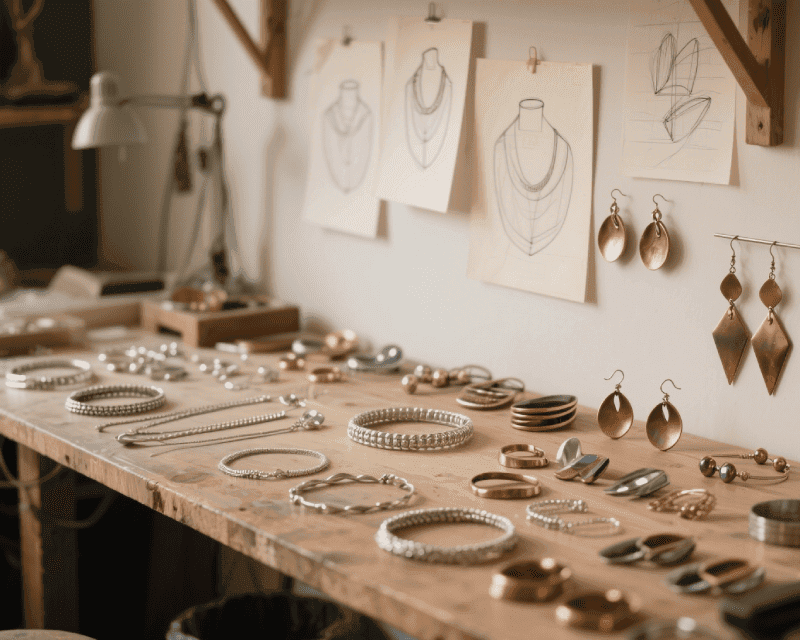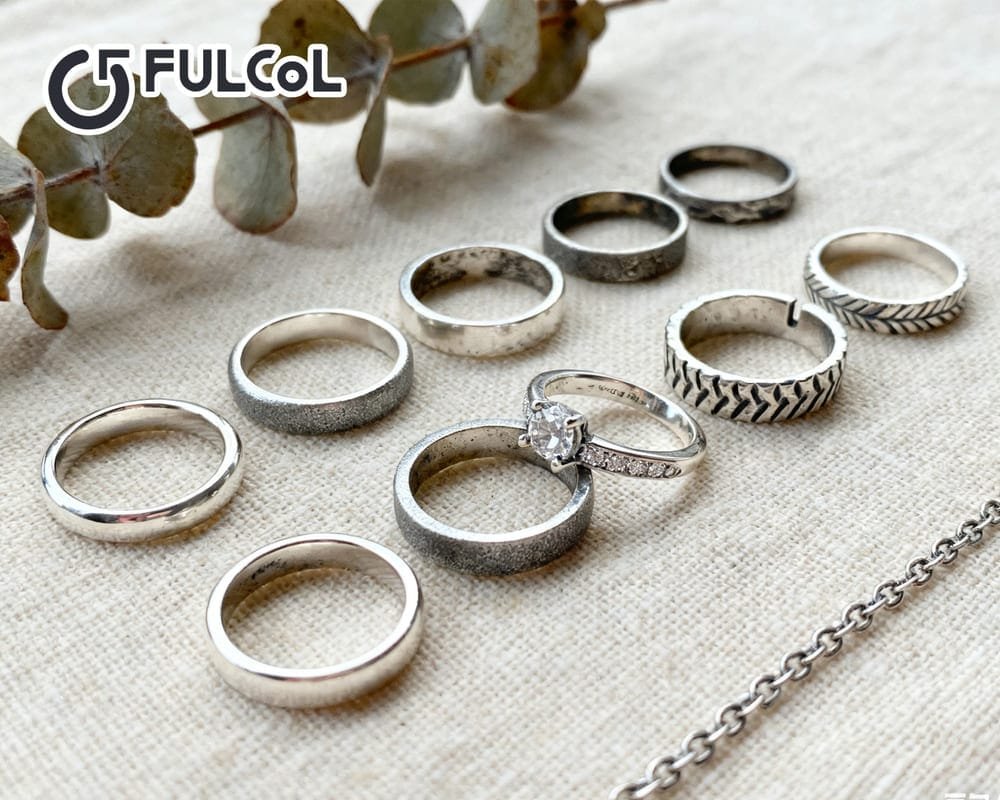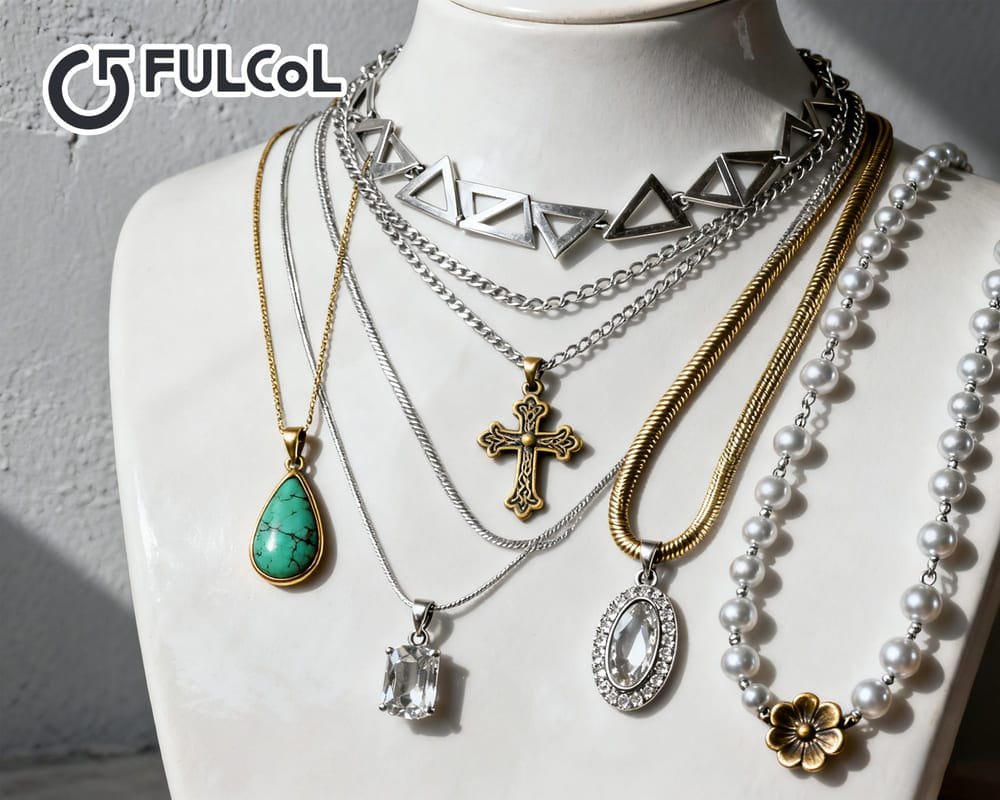In the jewelry industry, the continuous progress of surface treatment technology reflects people’s continuous pursuit of jewelry durability, beauty and environmental performance. Especially for custom jewelry made of brass, how to effectively prevent oxidation discoloration, paint fading and other problems is the most concerned topic for custom wholesale jewelry suppliers. Although traditional electroplating, spray painting and other processes have been used for a long time, they often have problems such as uneven film layer, poor wear resistance and poor environmental performance.
With the development of new materials and new processes, electrophoretic coating technology, as an advanced surface treatment technology originated from the automotive industry and electronic precision parts, has begun to be introduced into the jewelry manufacturing industry and quickly gained recognition among small batch jewelry manufacturers. It can not only enhance the surface beauty of the product, but also greatly extend the service life of the jewelry. It is a comprehensive technology that integrates protection, beauty and environmental protection.
Table of contents
- What is electrophoretic coating?
- Mechanism and advantages of electrophoretic coating on brass jewelry
- How do jewelry manufacturers introduce electrophoretic coating in production?
- Selection criteria for jewelry suppliers and comparison of electrophoretic process
- Specific process and common equipment recommendation for electrophoretic coating
- Common problems and solutions in electrophoretic process
What is electrophoretic coating?
Electrophoretic Deposition (EPD) is a process in which charged paint particles migrate and deposit on the surface of a conductive substrate under the action of an electric field to form a uniform film. Its core principle is to use the negatively or positively charged paint molecules in the electrolyte to move to the opposite electrode under the action of the DC electric field, and then deposit on the surface of the workpiece and form a dense and solid protective film through subsequent heating and drying.
In the jewelry industry, cathodic electrophoresis is commonly used, that is, the jewelry is used as the cathode, and the paint particles migrate from the anode to deposit. The biggest advantage of this method is that it is non-corrosive to the substrate, the coating film has good flexibility and high transparency, and can maximize the original color and details of the jewelry. Compared with traditional electroplating, the electrophoretic film layer is more uniform, especially in complex structures and gaps. It can also achieve effective coverage, thereby greatly improving the overall durability and visual consistency of the jewelry.
It is worth mentioning that the paint used for electrophoretic coating is mostly environmentally friendly water-based paint, which does not contain harmful heavy metals and organic solvents. It not only meets the EU ROHS, REACH and other environmental protection standards, but also helps the factory achieve green production goals. In today’s emphasis on brand social responsibility and sustainable concepts, this feature is particularly important for export-oriented jewelry manufacturers.

Mechanism and advantages of electrophoretic coating on brass jewelry
Brass is widely used in jewelry manufacturing due to its unique metallic color and good ductility, especially in the field of low-cost fashion jewelry. However, brass has poor chemical stability and is very prone to oxidation when exposed to air, sweat, perfume and other environments, resulting in surface discoloration, loss of luster, and even green rust, which seriously affects the wearing experience and consumer satisfaction.
The introduction of electrophoretic coating technology can provide brass jewelry with a transparent, dense and highly adhesive protective film, effectively blocking the penetration of oxygen and water vapor, and inhibiting the oxidation process from the source. At the same time, the electrophoretic film layer has a certain degree of flexibility and is not easy to crack, which is suitable for jewelry pieces with various complex shapes and thin-walled structures.
Specific advantages include:
Strong anti-oxidation protection: The electrophoretic film layer can isolate the jewelry from the outside air, sweat, and pollutants, significantly slowing down the oxidation rate of brass. According to actual measurements, in the salt spray test (ASTM B117), brass jewelry treated with electrophoresis has no obvious discoloration within 96 hours, while similar jewelry that has not been treated will have obvious rust spots on the surface within 24 hours.
Good wear and scratch resistance: The film hardness can reach more than 2H, which can better resist friction and scratches during daily wear, and prolong the maintenance time of the jewelry’s “new” state.
Maintain original color and color stability: The electrophoretic film layer has high transparency and does not affect the electroplating color or the metallic luster of the brass itself. It can also be used to achieve different decorative effects, such as transparent black, electrophoretic bronze, electrophoretic gold and other visual levels.
Reduce the risk of skin irritation: The copper and zinc elements in brass may cause skin sensitivity, while the electrophoretic coating can serve as an insulating barrier to reduce the probability of allergies and improve wearing comfort.
Improve brand quality: Jewelry after electrophoretic coating is more textured and shiny visually, and has a delicate touch, which is an important means for brands to improve product grades.
Therefore, electrophoretic coating is not only a technical path to solve the oxidation problem of brass jewelry, but also an important process guarantee for enabling jewelry products to develop in the direction of “high-end customization” and “environmentally friendly fashion”.
How do jewelry manufacturers introduce electrophoretic coating in production?
For small-batch jewelry manufacturers, fast product updates, small batches, and short cycles have become their normal operation. Compared with large-scale industrial production lines, such manufacturers need to find economical and efficient technical solutions in terms of equipment investment, operational flexibility, and quality control capabilities. Electrophoretic coating shows high adaptability in this context.
First of all, modern electrophoretic equipment has been miniaturized and modularized. The electrophoretic systems designed for small jewelry pieces on the market often occupy less than 2 square meters, and the power output is adjustable from 20V to 100V, which is suitable for micro-production lines that process dozens to hundreds of jewelry per day. The matching water-based paint can usually be recycled for one month, greatly reducing material loss and overall cost.
Secondly, for start-up brands or studios, if they do not have the conditions to build a production line for the time being, they can also adopt the “outsourcing processing” mode and hand over the rough or electroplated finished products to professional electrophoresis processing plants for processing. This method is highly flexible and does not require the cost of equipment and personnel training. It is more suitable for the production mode of market testing period or limited joint products.
In terms of operation process, even small manufacturers can refer to the following brief steps to implement electrophoresis:
- Workpiece pretreatment: Use an ultrasonic cleaner for degreasing and deoxidation to ensure surface cleanliness.
- Electrophoresis tank configuration: Adjust the coating concentration, pH value, conductivity, and set the deposition voltage suitable for the jewelry (usually 30-60V).
- Electrophoretic deposition: Place the jewelry on the fixture and power on for 1-2 minutes to complete the coating deposition.
- Cleaning and drying: Rinse the surface float with deionized water and send it to a constant temperature oven for drying (about 150℃, 10 minutes).
The above process can form a basic micro-electrophoretic processing unit. After the staff is proficient, it can complete the coating of hundreds of products every day, taking into account both efficiency and quality.

Selection criteria for jewelry suppliers and comparison of electrophoretic process
In cooperation with overseas brands and designer customers, they are often required to provide highly stable and traceable product process flows. Especially when electrophoretic coating becomes one of the key processes, the supplier’s electrophoretic process level directly determines whether the order meets the standards and whether the delivery date is reliable.
When selecting an excellent supplier, you should pay attention to the following key indicators:
- Film integrity and consistency: By comparing the film thickness, glossiness and color consistency of different batches of jewelry, judge whether the process is stable.
- Standardized operating procedures: Whether there are SOP operating documents, quality inspection records and equipment maintenance systems to avoid product deviations caused by manual experience dependence.
- Complete environmental certification: The coating should pass SGS testing and have EU REACH and ROHS reports to meet export compliance requirements.
- Ability to provide diversified coating effects: In addition to standard transparent films, whether it supports advanced decorative layers such as matte, electrophoretic color, and composite processes.
After-sales service and proofing capabilities: Whether you can provide fast proofing, adjust film thickness, and assist customers in developing exclusive coating effects is the key to measuring the depth of cooperation.
Specific process and common equipment recommendation for electrophoretic coating
The implementation process of electrophoretic coating includes multiple links, and each step is related to the coating effect, adhesion and final durability of the finished product. The following is the process flow of standard jewelry electrophoretic coating:
- Pre-treatment cleaning: Use ultrasonic cleaning equipment to degrease, dewax and remove the oxide layer of jewelry to ensure that the surface is clean and free of impurities. This step directly determines whether the electrophoretic film can be evenly attached.
- Activation treatment: Some processes will add activators for short-term soaking to make the metal surface more affinity with electrophoretic liquid and improve deposition efficiency.
- Electrophoretic deposition: Clamp the jewelry on the fixture, connect the cathode, put it in the electrophoretic tank, and power it on for 12 minutes.
- Deionized water rinse: After electrophoresis, it is necessary to spray or soak with deionized water immediately to remove the unattached coating residue on the surface and avoid stains after drying.
- Drying and curing: Use a high-temperature oven (130°C-160°C, time 10~15 minutes) to cure the coating to form a dense and firm transparent protective film.
- Inspection and packaging: Inspect the surface uniformity, thickness, adhesion, and perform salt spray test or color difference test, and finally enter the finished product packaging.
Recommended equipment:
- Small electrophoresis complete set of equipment: including power controller, electrophoresis tank (stainless steel/PP material), temperature control oven, deionized water system, cleaning table, suitable for daily processing of 300-800 pieces of jewelry.
- Semi-automatic fixture rotation system: Improve deposition uniformity, suitable for rings and necklace pendants with complex structures.
- Adjustable power controller: It is required to have a voltage/current automatic feedback system to prevent uneven coating due to current fluctuations.
- Environmentally friendly water-based electrophoretic fluid (recommended brands such as BYK, BASF, Wuxi Keda): ensure complete environmental certification, stable color, and long service life.
For start-up brands or small custom jewelry wholesale suppliers, you can also choose to outsource processing or rent electrophoretic process lines to achieve flexible expansion.

Common problems and solutions in electrophoretic process
Even mature electrophoretic processes may have quality problems due to improper operation or insufficient equipment maintenance. The following are common problems and solutions:
Film layer blooming, uneven color
- Cause analysis: The jewelry surface is not thoroughly cleaned, the liquid conductivity is abnormal, and the voltage is improperly set.
- Solution: Strengthen the pre-treatment process, regularly calibrate the liquid pH and conductivity, and use a dedicated power controller to accurately adjust the voltage.
The film layer is too thick/too thin
- Cause analysis: The electrophoresis time is too long/too short, and the voltage is too high/too low.
- Solution: Adjust the deposition time according to the type of jewelry, and control it within 1~2 minutes to avoid electrolytic corrosion or decreased adhesion.
Poor coating adhesion and easy to fall off
- Cause analysis: incomplete pretreatment, insufficient drying temperature or time.
- Solution: optimize the degreasing and deoxidation steps, ensure that the temperature in the drying stage is controlled within the standard range and fully heated and cured.
Micro bubbles or particles appear on the surface
- Cause analysis: electrophoretic fluid contamination, workpieces with water entering the tank.
- Solution: regularly replace or filter the electrophoretic fluid, and fully dry the surface of the jewelry before entering the tank.
Large color deviation
- Cause analysis: color difference of different batches of paint, unstable temperature and humidity affect the curing effect.
- Solution: use the same batch of paint uniformly, keep the operating area at a constant temperature and humidity, and test the color regularly for confirmation.
By improving the equipment maintenance process, standardizing the operation training system and setting up quality control inspection points, jewelry manufacturers can effectively avoid the above problems and ensure the quality of electrophoretic finished products.
| Start Your Custom Order | Email: info@fulcol.com | Number: +86 13055603907 |
In the current fiercely competitive jewelry market where product quality is king, electrophoretic coating has become an important weapon to increase the added value of jewelry with its advantages of environmental protection, durability and good visual effects. Small-batch jewelry manufacturers can effectively extend the product life, reduce the return rate, and enhance the brand’s professional image and market trust by introducing electrophoresis technology.
In the future, as consumers’ demand for “environmentally friendly jewelry”, “anti-allergic jewelry” and “long-lasting like new” becomes stronger, electrophoretic coating technology will play a more core role in jewelry manufacturing. Leading manufacturers such as Fulcol have established a firm foothold in the international custom jewelry supply chain with stable and mature electrophoretic production lines and rich experience. Whether you are looking for a solution to improve the texture of your product or want to find a reliable partner, electrophoretic coating will undoubtedly open a more shining and lasting future for your jewelry products.






